
Woburn is a city in Middlesex County, Massachusetts, United States. The population was 40,876 at the 2020 census. Woburn is located 9 miles (14 km) north of Boston. Woburn uses Massachusetts' mayor-council form of government, in which an elected mayor is the executive and a partly district-based, partly at-large city council is the legislature. It was the last of Massachusetts' 351 municipalities to refer to members of its city council as "aldermen".

The Boston and Lowell Railroad was a railroad that operated in Massachusetts in the United States. It was one of the first railroads in North America and the first major one in the state. The line later operated as part of the Boston and Maine Railroad's Southern Division.

The Lowell Line is a commuter rail service of the MBTA Commuter Rail system, running north–south between Boston and Lowell, Massachusetts. It is 25.4 miles (40.9 km) long, with nine stations including the terminals at North Station and Lowell station. All stations are accessible except for West Medford and Mishawum.
The Lexington and West Cambridge Railroad was a railroad company chartered in 1845 and opened in 1846 that operated in eastern Massachusetts. It and its successors provided passenger service until 1977 and freight service until 1980 or early 1981.

Ayer station is an MBTA Commuter Rail station located off Main Street in the Ayer Main Street Historic District of Ayer, Massachusetts. It serves the Fitchburg Line. There are three tracks through the station, two of which are served by a pair of low-level side platforms, which are not accessible. There is a shelter on the inbound platform.
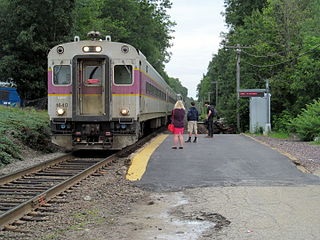
North Wilmington station is an MBTA Commuter Rail station in North Wilmington, Massachusetts. It serves the Haverhill Line, and is located off Middlesex Avenue (Route 62). It has some of the most limited station faculties on the MBTA system – a single short non-accessible platform serving the line's single track at the location, with a small parking lot and shelter for passengers. North Wilmington served by most Boston–Haverhill trains except for a small number that use the Wildcat Branch. It is a flag stop except during weekday peak hours.

The Wildcat Branch is a single track railroad branch line which connects the MBTA Lowell Line in Wilmington, Massachusetts to the MBTA Haverhill Line at Wilmington Junction. The total length of the branch line from the connection with the Lowell Line to the merge with the Haverhill Line is 2.88 miles (4.63 km). It was operated from 1836 to 1848, then rebuilt in 1874, and has been used since.
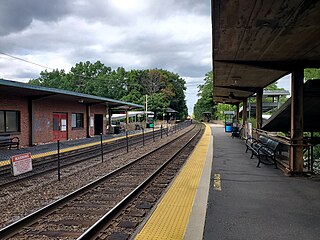
Wedgemere station is an MBTA Commuter Rail station in the southeast portion of Winchester, Massachusetts, served by the Lowell Line. The station has two side platforms serving the line's two elevated tracks. The 1957-built station building, largely unused, is adjacent to the inbound platform. After several years of work, the station was made fully accessible in February 2013.

Winchester Center station is a MBTA Commuter Rail station in Winchester, Massachusetts, served by the Lowell Line. The station is located on a viaduct in downtown Winchester, with two accessible side platforms serving the line's two tracks. The station was temporarily closed on January 8, 2021 due to structural deterioration; the first portion of the rebuilt station opened on October 1, 2024, with the remaining portion expected to open in late 2024 or early 2025.

Mishawum station is an MBTA Commuter Rail Lowell Line station located in the north part of Woburn, Massachusetts just north of the Route 128/I-95 beltway. The station has two side platforms serving the line's two tracks. Mishawum is a limited-service flag stop intended for reverse commuting to the adjacent office park, with no weekend service. With just 32 boardings on an average weekday in 2018, Mishawum is one of the least busy stations on the commuter rail system.

Framingham station is a historic Boston and Albany Railroad station located in downtown Framingham, Massachusetts. Designed by noted American architect H. H. Richardson, it was one of the last of the railroad stations he designed in the northeastern United States to be built. The station, built in 1884–85, served as a major stop on the B&A Main Line as well as a hub for branch lines to Milford, Mansfield, Fitchburg, and Lowell. After years of deterioration, the station was listed on the National Register of Historic Places in 1975 as the Framingham Railroad Station, and restored a decade later.
The Woburn Branch Railroad was a branch line of the Boston and Lowell Railroad ("B&L") and later of the MBTA Commuter Rail system that connected the Lowell Line with the city square in Woburn, Massachusetts.

Medford/Tufts station is a light rail station on the Massachusetts Bay Transportation Authority (MBTA) Green Line located off Boston Avenue near College Avenue in Medford, Massachusetts, adjacent to Tufts University. The accessible station has a single island platform serving the two tracks of the Medford Branch. It opened on December 12, 2022, as part of the Green Line Extension (GLX), which added two northern branches to the Green Line, and is the northern terminus of the E branch.
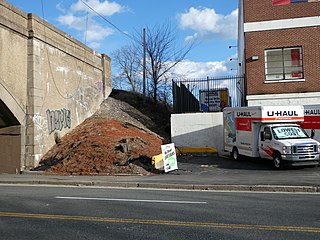
Mystic Valley Parkway station is a proposed light rail station on the MBTA Green Line in Somerville, Massachusetts; it would be built as part of a future third phase of the Green Line Extension (GLX). Route 16 would consist of one island platform, which would serve the E branch's two tracks.
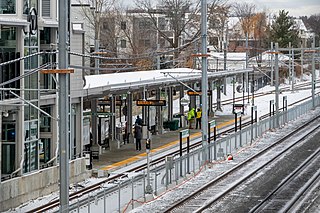
Magoun Square station is a light rail station on the Massachusetts Bay Transportation Authority (MBTA) Green Line located at Lowell Street south of Magoun Square in Somerville, Massachusetts. The accessible station has a single island platform serving the two tracks of the Medford Branch. It opened on December 12, 2022, as part of the Green Line Extension (GLX), which added two northern branches to the Green Line, and is served by the E branch.

Salem Street station was a short-lived commuter rail station in Wilmington, Massachusetts in use from 1959 to 1967. It was located at the Salem Street crossing. It was established by the Boston and Maine Railroad (B&M) as the sole stop on the Wildcat Branch, in the wake of a restructuring brought on by service cuts. In 1965, the Massachusetts Bay Transportation Authority started funding MBTA Commuter Rail service on the B&M routes, but closed Salem Street in 1967.
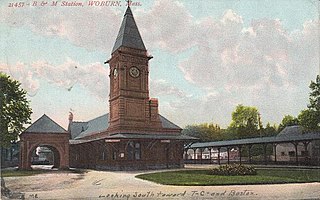
Woburn station was a railroad station on the Woburn Branch, part of the Massachusetts Bay Transportation Authority's Lowell Line.
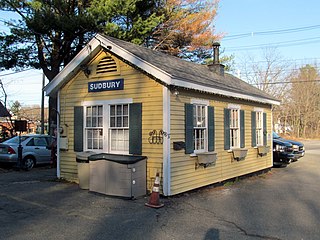
South Sudbury was a commuter rail station in Sudbury, Massachusetts. It was located at the junction of the Central Massachusetts Railroad and the Framingham and Lowell Railroad slightly north of Boston Post Road in South Sudbury. The Boston and Maine Railroad station was incorporated into the MBTA Commuter Rail through subsidies in 1965. The station was closed in November 1971 when the branch's last remaining round trip was discontinued. The 1952-built station building was a private business until its closure in 2019, and the building is now abandoned. In August 2023 the Massachusetts Department of Conservation and Recreation offered the building to the Town of Sudbury at no cost.

Lake Street station was a commuter rail station on the Lexington Branch, located in the East Arlington section of Arlington, Massachusetts. The line opened as the Lexington and West Cambridge Railroad in 1846, with a station at Pond Street among the earliest stops. It was renamed Lake Street in 1867. The Boston and Lowell Railroad (B&L) acquired the line in 1870 and built a new station building in 1885. Service continued under the Boston and Maine Railroad (B&M) – successor to the B&L – though it declined during the 20th century. Lake Street station and three others on the line were closed in May 1958. The Massachusetts Bay Transportation Authority (MBTA) began subsidizing service in 1965, and Lake Street station reopened in March 1968. All passenger service on the Lexington Branch ended on January 10, 1977; it was converted into the Minuteman Bikeway in the early 1990s.

Winchester Highlands station was an MBTA Commuter Rail Lowell Line station located at Cross Street in the northern part of Winchester, Massachusetts. It originally opened in the mid-19th century under the Boston and Lowell Railroad (B&L) as a flag stop called North Winchester. In 1877, a local real estate developer constructed a new station building, which was renamed Winchester Highlands. The B&L became part of the Boston and Maine Railroad (B&M) in 1887. Service to the station gradually decreased in the 20th century, and the depot was replaced by a wooden shelter around 1943. The Massachusetts Bay Transportation Authority (MBTA) began subsidizing service on the line in 1965. Winchester Highlands and two other stations with low ridership were closed by the MBTA in June 1978.



















